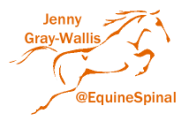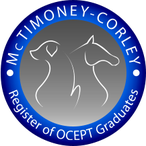A lot of the clients I see have issue with the horse not being straight. Horses, like people being left or right handed, tend to favour one rein over the other and without working to maintain straightness in the horse's work, this can lead to issues that I then pick up on during treatments.
Horses that have continuously been working crookedly start to show stiffness, sometimes leading to unlevelness, bridle lameness, incorrect strike offs in canter transitions, objecting to leg aids, cramping up when asked to go forwards.
In terms of what I feel when assessing the horses, they can have bulges of muscle on one side of their body, areas of spasm, poor flexibility and poor joint rotation (mainly one way to the other). The assessment of the back and pelvis can highlight soreness & weakness as the horse has been compensating his movement to make life easier for himself.
In a previous blog, on my website I wrote about muscle memory and how this can benefit the rider by good correct regular practice, making competition easier as you are well prepared and functioning on instinct.
Muscle memory is also a major part in straightness for the horse. If the horse & rider have steadily become more crooked, the muscles of both horse & rider start to feel the crookedness as the 'norm' and when asked to straighten up the feeling is alien.
This is where reconditioning the body (horse and rider!) and re-learning the correct positioning is so important. And I won't lie… it’s not that easy. What can slip into bad habits so easily for you both, can take twice as long to undo! That's the bad news out of the way.
Following the recent 2014 International Eventing Forum (which sadly I couldn't go to but enjoyed reading Alexis Ross' report for Eventing WorldWide) I read with interest that a lot of the speakers were discussing straightness & this involved control of the shoulders to achieve this & create a body position that the horse was able to use it's whole body to achieve highest levels of performance.
I have been working with some of my clients over the winter to achieve this - from my perspective, I want the horse to hold itself and the rider in the most economical & most effective way possible. I also want the horse to work in a way that it's body can go on to improve in muscle tone, suppleness and strength, because at the end of the day, it makes my life as a therapist so much easier!
Straightness really is the key for me - this is not to say that you can't bend and flex your horse when riding, but if you are not controlling the body while you do this, all your efforts disappear out the side door!
Riding your horse into a soft & forward outline needs to come from behind. The horse has to be forwards and straight & to do this he needs to be in front of your leg so you can sit and enjoy this! None of this is new information to you, I'm sure… but how aware are you of exactly how straight you are & the horse is underneath you? How aware are you exactly of where each leg is as you go into halt (without cheating and looking down!), the positioning of the horse's in walk, trot and canter, and when jumping? Do you always ride on a circle or around the track of the school, can you ride off the track in a straight line & be even in both reins?
Being able to ride the horse from behind, forward & straight and then being able to control that with your seat, weight & legs is the key. Then instead of steering with your reins, you start to steer with your body & leg pressure. Control of the shoulders then starts to come easier as you suddenly have a whole heap more neck in front of you as the front end is not being pulled around by the hand.
If you can learn to control the shoulder in this way, imagine how much easier that XC combination will be as you can keep your hand still & in the neck whilst your body & leg sends the horse as straight as a die over that tricky angled skinny on the exit.
In terms of the contact you have, I am not suggesting we all drop our reins & fly about forwards & straight, throwing the shoulders of our horses about with their heads in the air! Your contact needs to be level and this is where we think about how crooked we are as riders. Don't know about you, but I have a stronger hand, which is my right one. I call it my 'Tourettes Hand' as it tends to flail about of it's own accord despite my own efforts of me trying to keep it as still as possible. I tend to hook a bit on the hand too so have to make a constant effort to encourage my horse to take more in the left rein to keep the contact even and keep the right hand forwards to stop pulling on it!
A truly even steady contact isn't the easiest thing to achieve, but with control of the straightness & the shoulder, it's a hell of a lot more easy! Watching Charlotte Dujardin is a great example - she is really brave at putting her hands bang forward in front of her and having control of her horses shoulder neck with her body positioning.
Horses that have continuously been working crookedly start to show stiffness, sometimes leading to unlevelness, bridle lameness, incorrect strike offs in canter transitions, objecting to leg aids, cramping up when asked to go forwards.
In terms of what I feel when assessing the horses, they can have bulges of muscle on one side of their body, areas of spasm, poor flexibility and poor joint rotation (mainly one way to the other). The assessment of the back and pelvis can highlight soreness & weakness as the horse has been compensating his movement to make life easier for himself.
In a previous blog, on my website I wrote about muscle memory and how this can benefit the rider by good correct regular practice, making competition easier as you are well prepared and functioning on instinct.
Muscle memory is also a major part in straightness for the horse. If the horse & rider have steadily become more crooked, the muscles of both horse & rider start to feel the crookedness as the 'norm' and when asked to straighten up the feeling is alien.
This is where reconditioning the body (horse and rider!) and re-learning the correct positioning is so important. And I won't lie… it’s not that easy. What can slip into bad habits so easily for you both, can take twice as long to undo! That's the bad news out of the way.
Following the recent 2014 International Eventing Forum (which sadly I couldn't go to but enjoyed reading Alexis Ross' report for Eventing WorldWide) I read with interest that a lot of the speakers were discussing straightness & this involved control of the shoulders to achieve this & create a body position that the horse was able to use it's whole body to achieve highest levels of performance.
I have been working with some of my clients over the winter to achieve this - from my perspective, I want the horse to hold itself and the rider in the most economical & most effective way possible. I also want the horse to work in a way that it's body can go on to improve in muscle tone, suppleness and strength, because at the end of the day, it makes my life as a therapist so much easier!
Straightness really is the key for me - this is not to say that you can't bend and flex your horse when riding, but if you are not controlling the body while you do this, all your efforts disappear out the side door!
Riding your horse into a soft & forward outline needs to come from behind. The horse has to be forwards and straight & to do this he needs to be in front of your leg so you can sit and enjoy this! None of this is new information to you, I'm sure… but how aware are you of exactly how straight you are & the horse is underneath you? How aware are you exactly of where each leg is as you go into halt (without cheating and looking down!), the positioning of the horse's in walk, trot and canter, and when jumping? Do you always ride on a circle or around the track of the school, can you ride off the track in a straight line & be even in both reins?
Being able to ride the horse from behind, forward & straight and then being able to control that with your seat, weight & legs is the key. Then instead of steering with your reins, you start to steer with your body & leg pressure. Control of the shoulders then starts to come easier as you suddenly have a whole heap more neck in front of you as the front end is not being pulled around by the hand.
If you can learn to control the shoulder in this way, imagine how much easier that XC combination will be as you can keep your hand still & in the neck whilst your body & leg sends the horse as straight as a die over that tricky angled skinny on the exit.
In terms of the contact you have, I am not suggesting we all drop our reins & fly about forwards & straight, throwing the shoulders of our horses about with their heads in the air! Your contact needs to be level and this is where we think about how crooked we are as riders. Don't know about you, but I have a stronger hand, which is my right one. I call it my 'Tourettes Hand' as it tends to flail about of it's own accord despite my own efforts of me trying to keep it as still as possible. I tend to hook a bit on the hand too so have to make a constant effort to encourage my horse to take more in the left rein to keep the contact even and keep the right hand forwards to stop pulling on it!
A truly even steady contact isn't the easiest thing to achieve, but with control of the straightness & the shoulder, it's a hell of a lot more easy! Watching Charlotte Dujardin is a great example - she is really brave at putting her hands bang forward in front of her and having control of her horses shoulder neck with her body positioning.
Now… this is Charlotte & Valegro… so sadly, we can't all ride like her or be sat on a horse like him, but we can pretend we are. If we can emulate a small amount of this 'brave hand' and control of shoulders and horse's straightness with our bodies & legs, then there's a chance our horses will give that extra bit of performance that we all know them to be capable of, but were just inhibiting them from producing.

 RSS Feed
RSS Feed
